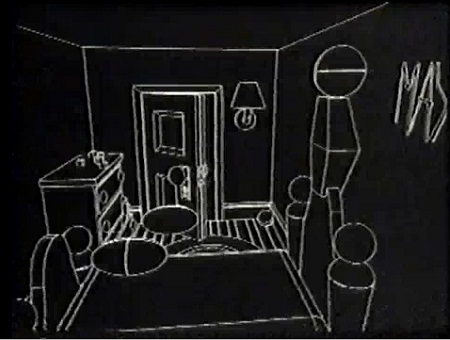The process we came up with to do the Wild Things test ended up being called Synthamation. In concept it was very simple – but God was in the details.
It all started with an animatic provided by the Disney team – a shot by shot view of the 3D background, created as a series of hand-drawn sketches. Then our artists at MAGI (Chris Wedge and Jan Carlée) worked from this animatic to create 3D models of everything – the room, hallway, bed, staircase, the little table with the lamp on it seen in the last shot.
Chris and Jan then computer animated a camera path through their 3D scene that matched the successive viewpoints of the hand drawn animatics. The result was rendered out frame by frame, not as a fully shaded background scene, but rather as a series of computer generated line drawings (called a “pencil test”). These pencil test frames of the 3D animated scene were printed out on big sheets of paper, so that the Disney artists could use them as a guide to rotoscope the frame by frame animation of the characters of Max and his dog.
Rotoscoping in those days was a process whereby an animator draws on paper while looking through a big piece of slanted glass. The animator sees the paper containing his own drawing through the glass, while simultaneously seeing another piece of paper containing a pencil test frame reflected by the glass. To the animator, it looks as though the two pieces of paper are superimposed on each other. So he can always see the computer generated pencil test of the background image, but the drawing he makes actually goes onto a clean white sheet of paper.
Here is where our team came up with a clever trick. When we rendered the pencil test, we added dummy versions of Max and his dog. These were only to guide the animator – they would not appear in the final animation. These dummy versions were really simple – each was just composed of a few simple shapes, as you can see in the image below. But that was enough to show the animator (in this case, Glen Keane) where to draw the characters for each successive frame of the animation.

The dummy characters also served another, more subtle purpose. In the final animation the hand-drawn characters are moving all around the scene – getting closer or further away, or running behind or in front of the staircase. The dummy characters allowed our programmers to know how far away to place the animated characters when they were finally composited into the scene. For example, in the final animation Max’s dog runs behind the staircase when he runs down the stairs – just like the dummy version of the dog.
When the animator was done, he had created various big stacks of drawings. Some of these drawings were of Max and some were of Max’s dog. We digitized each drawing into the computer at high resolution, using an Eikonix flatbed scanner. Once we had all the pieces scanned into the computer, all that remained to do was combine those pieces together in software, and add shading and lighting.
That last bit is not as simple as it might seem. We wanted the hand-drawn animated characters to appear not flat, but rather rounded and three dimensional – as though they were being lit along with the rest of the 3D scene. We also wanted them to cast shadows onto the floors and walls of the 3D computer generated background. And the background itself needed to have a kind of magical storybook appearance. To do all that, we needed to invent a few new techniques.
But that’s a topic for tomorrow.
A topic I’d like to see covered in this series, “Why has Ken choosen to do the things he has and not the things he hasn’t?” In simple terms, “why doesn’t Ken work for Pixar?”, if that is a question that has meaning. Given the context of this series it is something I’ve been curious about. Last year I read the book, “The Pixar Touch”, to the best of my knowledge, David Price didn’t answer that question, maybe you can.
Pixar is awesome, and a lot of those guys are good friends of mine. I’ve felt the same way at various times about research groups at Apple, Microsoft, Sony, MERL and other places where exciting things have happened.
But I think I’m just not wired to work for a company. Once I discovered the incredible freedom of working at a research University, a place where I can essentially be my own boss and explore in any direction that feels exciting, I never looked back.
I think Ken you found the place you belong to and that makes you so damn good in what you are doing – so damn good that I go green with envy and admiration. 😉
I blush. 🙂